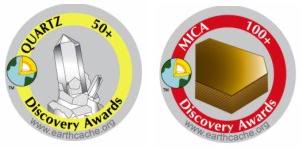1. Are the 2 boulders Black Canyon onyx or Grand Canyon Red onyx?
2. Is the monument/wall made of Black Canyon onyx or Grand Canyon Red onyx?
3. Were the finished tiles of the monument cut in the same direction as a vein, or where they cut crossing a vein(s)?
4. What is the thickness of the widest band found in the largest boulder?
5. Are the layers/bands straight and parallel in the boulders?
And for the wanderers.....(extra credit)
6. In what year was onyx discovered at Big Bug Station?
The city of Mayer:
Mayer, established in 1882, was originally known as Big Bug Station. It was the main stop between Phoenix and Prescott on the Black Canyon Road. The buildings located here were completed in 1904 and included a saloon, a dancehall, a mercantile and a barber shop. Big Bug is also the site of a nearby onyx mine.
Onyx Basics:
Agate, onyx, and sardonyx are all banded varieties of chalcedony. Chalcedony is a cryptocrystalline form of silica (very fine grained quartz and moganite). Agates generally exhibit concentric, irregular and ill-defined bands ranging from white to brown or sometimes bluish colors. Sardonyx has straight parallel bands ranging from white to reddish-brown or red (sard). True onyx consists of predominantly black and white and has straight, alternating, parallel bands. Agate, onyx, and sardonyx all have a hardness's of 6 to 7 on the Mohs' scale and fracture conchoidally (randomly) upon impact.
Formation:
Onyx is created by a process called precipitation. Precipitation occurs after minerally saturated groundwater fills openings and fissures within a parent rock, such as in the gas cavities found in lava. As the liquid drains, the minute solids (various minerals) are left behind, creating layers/bands. Color changes in the bandings are caused by the slight changes in the chemical composition of the ground water during this process.
Definition:
The name "onyx" comes from the Greek word for claw or fingernail. This is because of its often fleshtone color and its resemblance to a fingernail. It is found in many regions of the world, including Brazil, Uruguay, Pakistan, Sri Lanka, India, Madagascar and Hawaii. Used in jewellery, it is usually cut as a cabochon or into beads. It can also be used for intaglio and cameo type engraved gems, where the bandings make the image contrast with the ground. Banded calcite, which forms in cave systems and is often carved into book ends and chess sets, is actually a type of (dyed) alabaster, and not an onyx at all. This type of rock has been called "Mexican onyx" or "onyx-marble" throughout the ages. The use of these names has resulted in the term "onyx" being incorrectly used to mean any banded material, which is not the original definition of the word.
At the Quarry (private property):
The quarry lies along Big Bug Creek in Mayer and can be seen to the north side of HWY 69. This quarry has the richest deposit of onyx found anywhere between Prescott and Puebla, Mexico. A core drilling study recently conducted revealed that the deposit of onyx is at least 180 feet deep. A typical deposit of onyx is generally 3 to 6 feet deep, and a deposit of 9 to 13 feet is considered to be an outstanding deposit. 2 predominant varieties of onyx are found at this quarry. The first, Black Canyon, is predominantly black and white, with a combination of dark brown, black, gray, beige, caramel and cream swirls. The second, Grand Canyon Red, is predominantly a dark reddish/orange mix with beiges and browns and small circular swirls of black, cream and light orange. The onyx quarried here is said to be harder than typical onyx varieties found elsewhere. Current production stands at 500 tons of stone per month. After blocks are pulled, the stone can be cut and polished either vertically or horizontally. When cut in the same direction as a vein, the surface will show the coloration of one layer. When cut crossing a vein(s), the surface will show the color contained in multiple layers.
At the coordinates:
Once reaching the site you will find 2 different sized raw (uncut) onyx boulders and a cut and polished onyx monument/section of wall. Use these 3 items to answer the questions below. Email your answers to me, using the link in my profile only. If your answers are not received by me, your log will be deleted. Photos are accepted and appreciated of the buildings but do NOT show the rocks or the monument. You do not have to wait for confirmation from me before logging this cache as completed. Most of all……learn……and enjoy the view.
